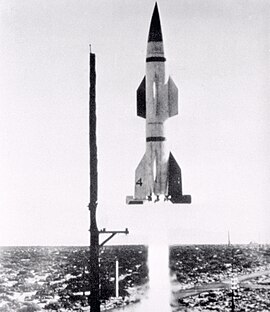Hermes project

The first Hermes A-1 test rocket, fired at White Sands Proving Ground
|
|
| Function | A-1: Experimental |
|---|---|
| Manufacturer | A-1 (1946): General Electric |
| Country of origin | United States |
| Size | |
| Height | A-1: 300 in; A-3B 396 in |
| Diameter | A-1: 34 5/8 in; A-3B 47 in |
| Mass | A-1: 3000 lb; A-3B 5139 lb |
| Launch history | |
| Status | Retired |
| Launch sites | White Sands Proving Ground |
| Total launches |
58 |
| Boosters | |
| Thrust | A-3B: 22600 lb-force |
58
A-1: Five (May 1950-April 1951)
The Hermes project (November 15, 1944 - December 31, 1954), was started in response to Germany's rocket attacks in Europe. Project Hermes was to determine the missile needs of army field forces. "Accordingly the Ordnance Department entered into a research and development contract with the General Electric Company on 20 November 1944. "This contract authorized the General Electric Company to seek the development of long-range missiles that could be used against both ground targets and high-altitude aircraft. The contractor agreed to perform investigations, research, experiments, design, development, and engineering work in connection with the development of long-range missiles for use against ground targets and high-altitude aircraft." General Electric was also to investigate ramjets, solid rocket motors, liquid propellant rocket engines, and hybrid propellents. "The contract also required the General Electric Company to develop remote control equipment, ground equipment, fire control devices, and homing devices."
Hermes was the Army's second missile program. In May 1944 the Army contracted with the California Institute of Technology's Guggenheim Aeronautical Laboratories to start the ORDCIT Project to research, test and develop guided missiles. The Hermes program originally was to have three phases; first would be a literature search, second a research group would be dispatched to Europe to investigate the German Missiles, third "it would design and develop its own experimental systems. Basically, this project covered every phase of missile technology with the exception of large-scale development and production of warheads and fuzes. However, . . . these many areas may be grouped within three general categories, namely, the A1 and A2 missiles, the A3 missiles, and all other Hermes missiles and supporting research."
In December 1944, Project Hermes was tasked with studying the V-2. Subjects which were to be addressed were ". . .transporting, handling,unpacking, classifying (identifying) , reconditioning and testing components of German rockets as well as assembling and testing subassemblies ahd (sic) complete rockets, manufacturing new parts, modification of existing parts, conducting special tests, constructing temporary test equipment not available at the Proving Ground, procuring and handling of propellants and supervision of launching rockets." Project Hermes's mandate created a need for an extensive area where missiles could be safely tested. The Army moved to create the White Sands Proving Grounds in south central New Mexico as a place to test the new missiles.
When the U.S. Army captured the Peenemünde engineers, including Werner Von Braun, Dr. Richard W. Porter of Project Hermes was close behind. Following the capture by American forces of the Mittelwerk V-2 factory, Special Mission V-2 swept in and scooped up enough components to assemble 100 V-2s. The components were quickly removed to New Mexico. Three hundred rail cars of V-2 parts and documentation arrived at the White Sands Proving Grounds and General Electric personnel started the task of inventorying the components. For the next five years overhauling and manufacture of parts, assembly, modification and launching V-2 rockets would be the major part of Project Hermes. Many of the V-2 components were in poor condition or unusable.
...
Wikipedia
